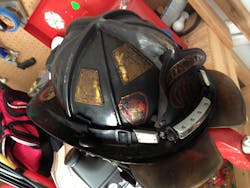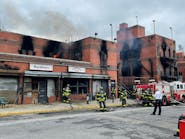Is your helmet burned beyond recognition? Over the past two or three months, this topic keeps coming up for discussion over the Views From the Jumpseat social media channels. Does the state of burn shown on your helmet really tell the tale of how skilled a firefighter you really are?
Alternatively, should the firefighter with the burned up lid be shunned and cast off the island like the loser on "Survivor"? Let us pull back the curtain and expose some key points in this discussion. Charred helmets have been widely looked upon as cool and a thing of pride in the fire service. I hope that after this blog your opinion will change, just as mine did.
I can vividly remember my first day walking into the fire station. After being introduced to the firefighters, I was given a tour of the fire station including the gear lockers. The gear being racked was in perfect order and there stood everyone’s helmet. One after the other. Clean, clean, and burned to a crisp! Wow is all I could think as I stood there looking at this firefighter’s battle-hardened helmet. They must be the best firefighter as their helmet looks like they had been there and done that, I thought.
This memory came back to reality a few weeks back when sharing the experience of live fire with a Firefighter 1 class. We had our safety briefing, went over the learning points for the day, and I headed into the instructor's room to put on my burn gear, which included my favorite helmet. It has seen its better days. Ten years and two departments later it had become a helmet that is used strictly in the burn room. It was melted fairly bad. When I came out of the instructor’s room, wearing this "battle-tested" lid, their eyes lit up as if it was Christmas morning. Not a word was spoken but I could see the look in their eyes.
Why do so many firefighters look at our helmets in this way? Looking back on the situation, why was the instructor wearing such a tattered lid?
When we are exposing new firefighters to our world we should lead by example. As a live fire instructor, our helmets do catch more heat as we build realistic fires for them to experience. Is this the example we should be setting? It seems kind of hypocritical that we say one thing and then show just the opposite. Burning up your helmet in a burn room can be done easily as the radiant heat can be intense. I think we need to either explain this or change our helmets to reflect our teachings.
Let us review some facts about radiant heat and your fire helmet:
- Polycarbonate melts at 450 degrees
- Inside a fire, one foot equals a 100-degree change in temperature
- Your helmet is only inches from your facepiece
- How toxic the smoke is as we are crawling into it
If you are beginning to see your helmet’s eyeshields melt, what do you think could be next? It has been well documented that face pieces begin to elongate or “Pinocchio” at temperatures hit the 350-degree range. If your helmet is beginning to melt, your face piece could be next. This is a recipe for death! If we are in a place that causes our helmets to begin to melt this is a place where we do not need to be, period!
Another big concern with any of our PPE is the exposure to carcinogens produced by the toxic smoke. These byproducts of combustion can produce harmful, cancer-causing particles that can saturate your helmet. Just as you remove it and hang it back on the shelf you will be exposed to these particles and if you don’t clean it you can be exposed over and over. Who cleans their helmet, right?
I must admit for years I have always believed in the notion to “never clean your helmet” and some sagging Bourke’s “look cool." In retrospect, maybe I was looking at it the wrong way. It is time for us all to visit this sensitive topic and adjust our point of view. Neither a “Burn Room Warrior," nor a firefighter that has had a near-miss are things to be proud of. Let us be proud that we clean our gear, including our helmet to make sure that we all go home, cancer free!






